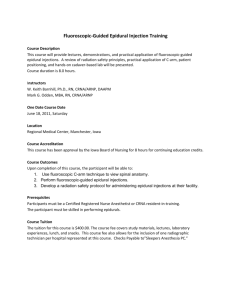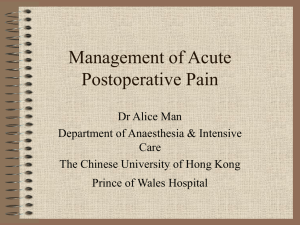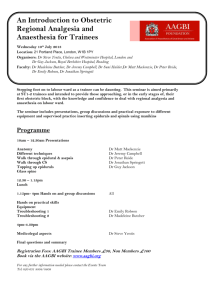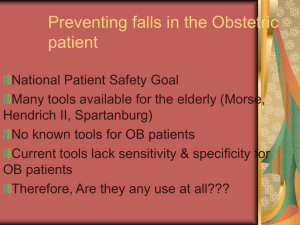Regional Anesthesia : Is it Worth the Effort? Regional/APS Rotations
advertisement
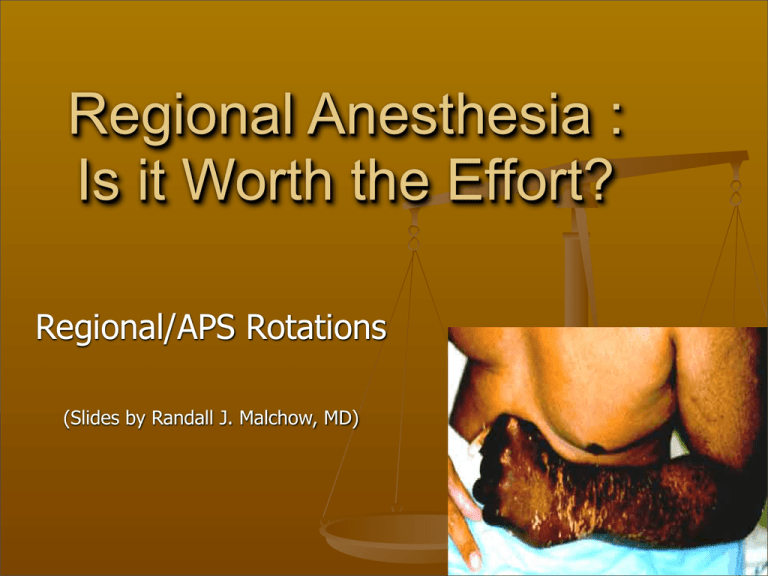
Regional Anesthesia : Is it Worth the Effort? Regional/APS Rotations (Slides by Randall J. Malchow, MD) Regional Anesthesia: Is it Worth the Effort? n n Benefits- why should we bother? Risks- what are the concerns? n Decreasedn n n n n n n Regional AnalgesiaImprovement in GA side effects/ complications Opiate Side Effects Blood Loss, DVT LOS, Hosp Cost Ileus, constipation, N/V Stress Response Chronic Pain n Improvedn n n n n OR Efficiency PACU Recovery and rehab Post-op Analgesia Patient Satisfaction Surgeon Satisfaction Decreased Issues w General Anesthesia n n n CNS n n n <Postop delirium <Cognitive Dysfunction <Drowsiness Airway n n n Cardiovascular n n <Sore throat, trauma <Difficult airway <Aspiration risk <HR, BP changes (avoiding intubation, incision, emergence) < Logistical requirement (monitoring, equip, personnel) n n Waters, 1997, A&A 3rd World Application Decreased Opiate Complications n Sedation- monitoring, treatment n n B/T Cell Dysfunction n n n n n (Payen, ’07; Lucas). > sedation assoc w/ CV failure/ spt and death in ICU Vallejo, ’04: < Ab prod, NK cell activity, cytokine express, phag act Hypotension Pruritis Bladder Dysfunction Opioid Induced Hyperalgesiauniversal w/ chronic use n n Respiratory Depression n < use of basal rates on wards GI: n Constipation/lleus n Nausea/vomiting Decreased Cost n < Unplanned Admissions (outpts): n n n n < Length of Stay (LOS) Inpts w CPNB n n n Williams ’04: 948 ACL cases reviewed 4% unplanned admissions (comp to 17%) Annual Savings: 1.8 million based on 3000 outpt ortho cases/yr Vandy Pilot Study: Amputations, Trauma, Others Duncan, Hebl, Mayo Clinic (2009 RAPM) Epidurals: n < ICU stay, hosp stay Decreased GI Side Effects, Blood Loss, and DVT n < N/V: n n n n n GA: 13-32% vs cle for knee scopes Spinal: 12-18% (unopposed vagal activity) Epidural: 3-9% PNB: 1-5% n n Mechanism: n n Sympathectomy w/ epidurals Opiate sparing w/ all RA < Constipation: n < Blood Loss: n < Post op Ileus: n n n universal even w/ low dose n Stevens, ‘2000: THA (60) < Bld Loss in LPB grp < Bld Loss w/ Spinals/Epid w/ THA Mech: < BP as well as avoiding positive pressure vent (>CVP) < DVT, PE: n n Epidural/Spinal studies in Total Joints, Trauma, Vasc Pts ? Diff w DVT prophylaxis Decreased Stress Response n n n n What is it? (Desborough) n SNS activation n Endocrine response n > pituitary (acth, gh, vasopressin) n Insulin resistance n Immune/heme changes n Cytokine prod n Lymphocyte prod Correlates w/ severity of trauma (Seekamp) Pain directly accentuates stress response Effective Acute Pain mgmt < Stress Response Decreased Chronic Pain: n n n Acute Pain assoc with Chronic Pain (Kehlet, Lancet) Epidurals & Post Thoracotomy Pain Syndrome: Obata, 1999, CJA n n n n n n n Preop epidural, dose prior to incision Intraop infusion Min IV narcotics Avoid high conc of LA(>hypotension and motor block) PCEA beneficial: eg 8ml/hr; 2ml dose/30min Toradol 15-30 mg qid x 2-3 days helpful (shoulder pain) < Chronic Pain n PVBs < Chronic Pain Breast Surgery (Kairaluoma, 2006, A&A) Amputations n Bach, Pain, ’88 n n n n n RCT, prospective Preop Epidural x 3d vs narcs Postop: Meperidine/Tylenol PLP: 0% Epid grp vs >30% at 1 yr for narcotic grp Fisher, A&A, 1991: n n n n n AKA/BKA, older, vasc (11) SCI CPNB placed intraop Postop, B 0.25% x 3d 90% reduction in opioid consumption No PLP at 1yr. Decreased Respiratory Complications: n Epidurals n n Helpful w/ Long Bone Fx’s, Pelvic Fx’s, Wound vacs Improves Outcome for Thoracic/ Upper Abd trauma (Hedderich; Ballantyne, 1998, A&A) n < Atel, secretions, pneumonia, resp failure, n > cough, VC, paO2 n Rib Fractures: n n n < pneumonia, ARDS; > cough, DB, insp force, TV < mech vent, ICU stay Opioids synergistic w/ Local anesthetics and more effective w/ stress response n PVBs and Rib Fx’s: n Karmakar, Chest, 2003: n n n n n Unilat MFR’s T3-8 PVB caths 2-3cm in space (50% difficulty) 20% contralat sprd; some epid spread. < VAS, RR; > SaO2, FRC, PEF Decreased Mortality and MI (Thoracic Epidural Analgesia) n Rodgers, 2000, BMJ. n n n 30% decr mortality w/ epidural analgesia in >9500 pts Rib Fractures: n < mortality 20% to 10% (Victorini) n Esp elderly w/ >> rib fxs < MI, ischemia n n Beattie, 2001, A&A > Cor Bld Flow Improved OR Efficiencyn Williams ’00: ACT+Turnover Times: n n n Model: Block Room, staffed similar to BAMC 369 ACL, 3yr retrospective review, same surgeon, Penn. Results: n n n n n PNB PNB + GA GA 31 min 36 min 41 min Decreased total “In-Room Anesthesia Time/ACT” compared to GA Recovery Fast Track n n Bypass Phase I Minimal Phase II Recovery Improved PACU Recovery n Ford et al, 2001: 801 pts, retrospective review (GA vs PNB vs combined) n n n n Williams ’00: 369 ACL study n n n n n < need to tx N/V (6% vs 20%) < need for suppl O2 (12% vs 81%) < discharge times (51min vs 104min) < need to tx N/V (9% vs 39%) < pain (14% vs 63%) 82% able to bypass PACU (Williams) Combined tech: intermediate results Less nursing care required Improved Post-Op Analgesia and Rehabilitation n Excellent analgesia- up to 30 hours n n n n Horlocker, ’02: TKA w/ SAB +LPB cath x 2d (0 narcotics postop, only tylenol/ketorolac) Mulroy, ’01: FNB for ACL’s. 24hr analgesia. Minimal nursing requirement Significant opioid sparing effect n Total Joints and CPNB: 56 TKA: GA w/ Cont Lumb Epidural (CLE) vs CFNB vs IV PCA x 3 days. Capdevila, ’99 n n CLE and C-FNB: < pain, > ROM, < Rehab time. C-FNB < side effects Improved Patient Satisfaction n Wu ’01: Review Article on Regional Anesthesia and Pt Satisfaction; Meta-analysis n n n Complex issue w/ many determinants 18 trials comparing RA vs GA ref pt satisfaction 70% trials RA> GA pt satisfaction n n n n Borgeat, ’98: PCIA vs PCA, shoulder: 9.6 vs 7.5 Vloka, ’97: FNB/GFNB vs SAB: 100% vs 81% Postop analgesia more critical than intraop anes plan (pt sat) Judicious sedation impt Improved Surgeon Satisfaction n Waters, A&A, ’97: 677 patients, all Reg Anesthesia n n Day of Surgery Satisfaction Improved "Can't really argue with if: results. Nobody wants to hear n n n n Minimize delay No complications High success rate < Problems Postop: n n n 96% surgeon satisfaction < Calls for Pain and PONV; ER visits; < ALOS (ave length of stay) for inpts > Pt referrals with Excellent Pain Mgmt Program patients cry about pain. I will miss your service more than any other at Vanderbilt. It actually is one of the things I most fear about leaving...not having a quality pain service.“ - One of many Vandy surgeons commenting on the APS Upshot on Benefits: n n Widespread > Outcome: CNS, Cardiac, Resp, GI, GU, LOS/Cost, Chronic Pain, Efficiency, and Mortality Continuous techniques (Cont Epid or CPNB): n n Amplify benefit Richman: n n n n meta-anal of 19 studies in 603 CPNB pts: < VAS, n/v, sed, pruritis Thor Epidural Analgesia > Benefit than Lumbar Combined w/ GA: n n Somewhat < benefit comp to RA alone > Recovery times, > N/V II. Risks- What are the concerns? n The “Big Three” PNB Risks: n n n n n LA Toxicity Pneumothorax Nerve Injury Central Neuroaxis Risks Other Local Anesthetic Toxicity n Prevention of LA toxicity: n n n Incidence of Seizures: n n n Auroy, Anes 1997; Brown, A&A, 1995 1:1000 rate with pnb Usually not assoc w/ cardiac toxicity (even w/ bupiv) n Avoid Bupivacaine Avoid Immobile needle? Extreme vigilance while injecting n n n n IV injection poss even w/ neg aspiration Aspiration after every 5cc’s Use of vasc marker w/ nerve stimulation Recognize S&S of IV injection Local Anesthetic Toxicity Treatment n Rx Seizures ASAP n n Protect IV Induction agent (propofol most common) n Airway (from support to intubation) n ACLS/CPR if necessary n Intralipid immediately available (LA talk) n Acidosis, anemia, hypoxia, hypercarbia, and hyperkalemia all increase risk n Amiodarone (vs lido), vasopressin (vs epi) Defibrillation n Dave Brown Pneumothorax n n n Supraclavicular: n 1-5% in some older series n Franco: 0 ptx’s in 1001 SCB’s Paravertebral: n 1:300 risk n N.B. scoliosis, other Interscalene (0.2% Borgeat), Infraclavicular: rare Pneumothorax n If concernedn n n n n avoid PPV/N2O Consider CXR Rtn to ER if CP, SOB Chest Tube if >25% or severe sx’s. n Remember Other Pulm Complications: n n Prevention: n n n > training, education Use of ultrasound Closed systems Phrenic Block (dep on conc; eg anes vs analg) n n n ISB 100% CPB 100% SCB 40% Bronchospasm: n ISB Nerve Injury n ASA Closed Claims Proj, 1990,1999. n n Epineurium Perineurium n n 0.2-2% Incidence (defn, diff dx, etc) Stan, ’95, Reg Anes. n Endoneurium n n N. injury more common under GA (61% of injuries under GA comp to 39% under Reg) 70% of UE inj assoc w/ GA 90% of LE inj assoc w/ RA (esp SAB) Incidence < w/ time; Borgeat, ’01, ISB’s. 4% at 3mos, 0.2% at 9mos No diff w/ CPNB vs single shot (Bergman, ’03) J. Hand Surg, ’96: n 21% of Hand surg seen “major n. inj” fr AXB. Nerve Injury: Incidence/Signs and Symptoms n Incidence: n n n n n Spinal: 1:1700 Epidural: 1:5000 PNB: 1:2500 (no difference w/ CPNB) > Incidence in Diabetes, other (“Double Insult” Signs/Symptoms of Intraneural Injection: n Pain/Paresthesia n n n but not always High Pressure USG (nerve enlargement) Nerve Injury- Mechanism n Trauma n n n n n Toxicity n n n Needle Stretch Compression (eg hematoma) Injury/surgery All local anesthetics Adjuncts? Ischemia n n n Tourniquets Casts/splints Intraneural injection Nerve Injury n Prevention: n n n n n n Communication, consent, sedation, avoid intraneural, avoid >> conc, avoid >1:200k epi, use of Ultrasound? 1ml test dose (detect paresthesia, high pressure, and/or nerve enlargement) Never direct needle directly at nerve (only “6 and 12 o’clock”) Gentle technique Nerve Stimulation as tool to avoid intraneural injection (“neg nerve stimulation at 0.5mA) Treatment: n n n n Complete hx/PE: (diff dx… preexisting, surgical, posn, tourniquet, other) Symptomatic Rx w/ multimodal Rx (eg anticonvulsants) Consider EMG/NCV studies Reassurance n “we wish to emphasize that spinal anesthesia – conducted under routine conditions in a standard manner- carries a poorly understood potential for sudden cardiac arrest in healthy patients.” -Closed Claims Analysis Bradycardia n Vasovagaln n n n n n ISB esp right side sitting position Early use of Atropine Hypotension n Sitting- most common Sedation premed helpful > young pts; somewhat indep of block level Bezold-Jarisch Reflex n n n n 10% profound w/ Epidurals/spinals NB elderly, hypovol. Epinephrine toxicity n n Cardiac Risks esp > 250mcg SQ/pnb Cardiac Arrest: n 1:1500 for spinals (vs < 1:7000 for PNB and epidurals) (Auroy, 1997, Anes) Other Risks n Other Central Neuroaxis Risks: n PDPH: n n n n Other PNB Risks: n n n n n n n ISB’s 60% n n LPB (10%) GA n n 30% incidence Avoid bupiv and epi Epidurals n ISB’s 15% Soreness - 10-40% “Failure” - 10% Epidural Spread – Spinals n Hoarseness n Urinary Retention: n Horner’s n 2% w/ Pencil point needles Age, guage, other factors Lumbar > thoracic 5% incidence in hi risk grps (hernia, GU, perirectal) Inability to Ambulate (lumbar/low thor epidural) n Critical to place low thor epidurals no lower than T10 n Infection: n Incidence: n n n n n n n n Vascular Injury n n Deep pain w/ abscess Erythema, swelling Temp, WBC late findings Prevention: n n 1<10,000 (single-shot) 1:1000 for epidurals < 1% CPNB’s (dep duration, other) Signs and Symptoms n n Infection and Vascular Complications Remove NLT POD4 (Home caths) DM, Steroids, Burns > risk Treatment: Vasospasm 1% Hematoma 0.2% n n n n n Klein, Anes ’97 Lovenox 30 bid Lumb Plx Hematoma w/ plexopathy on POD9. Rare Risk of hemorrhage (Mult case rpts of hemorrhage/ death w/ deep PNBs in anticoagulated pts Dissection, Aneurysm Epidural Hematoma n Prevention: n n n n n n Avoid epidurals/spinals w/ coagulopathy, lovenox, plavix, other Know coag status prior to placement and withdrawing cath Participate in DVT prophylaxis plan No significant risk w/ only ASA, NSAIDs (altho additive risk) Excellent Update: RAPM, Jan/ Feb 2010 Signs and Symptoms: n n Increasing LE motor block, Back pain (50%) n n If concerned, < local anes concentration, strict observation w/ serial exams (esp if intubated) If positive S&S’s, MRI and decompression within 8 hrs Upshot with Risks n Remember the “Big Three” n n n Improvements w/ LA toxicity, Pneumothorax Yet neuropraxia still concerning PNB/CPNB may < Risks over Central Neuroaxis (Giaufre, 1996, A&A) n Cardiac Arrest n n Spinal assoc w/ greatest risk Epidurals in Intubated Pts n n Very High risk procedure Check coags, volume status, septicemia, spinal injury concerns Conclusion n n n Benefits Risks Questions and Answers?

